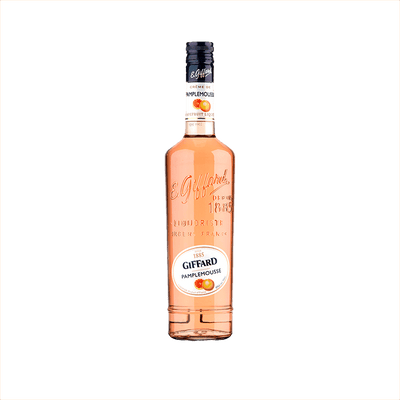Grapefruit Liqueur
What is Grapefruit Liqueur?
Grapefruit liqueur is a vibrant category within Fruit Liqueurs that captures the bright, bitter-sweet essence of fresh grapefruit through careful extraction and blending with neutral spirits and sweeteners. These liqueurs typically balance the citrus fruit's natural tartness with just enough sugar to create a drinkable spirit that retains grapefruit's characteristic bite and zesty aromatics. What defines grapefruit liqueur is its ability to deliver both the fruit's sunny brightness and its distinctive bitter edge, making it a versatile ingredient that adds complexity to cocktails while maintaining that unmistakable grapefruit character.
Learn More About Grapefruit Liqueur
What makes Grapefruit Liqueur unique?
Grapefruit liqueur stands apart from other fruit liqueurs with its distinctive bitter-sweet profile that balances citrusy brightness against a pleasant underlying astringency. While most fruit liqueurs lean heavily sweet or tart, grapefruit brings that characteristic pith bitterness that adds complexity and prevents the cloying sweetness common in cherry or peach varieties. This natural bitter edge makes grapefruit liqueur particularly versatile in cocktails, where it can add depth without overwhelming other ingredients the way intensely sweet berry liqueurs might.
How is Grapefruit Liqueur made?
Grapefruit liqueur starts with either fresh grapefruit peels that are macerated in neutral spirit to extract their essential oils, or grapefruit juice that's combined with a spirit base like vodka or rum. The citrus-infused spirit is then sweetened with sugar syrup to balance the natural tartness and bitterness of the grapefruit, with many producers adjusting the sugar content to achieve their desired flavor profile. Some artisan distilleries take an extra step by redistilling the macerated peels with the spirit to create a cleaner, more concentrated grapefruit flavor.
How do you drink Grapefruit Liqueur?
Grapefruit liqueur shines brightest when mixed into cocktails rather than sipped neat, as its intense citrus punch can be overwhelming on its own. You'll find it starring in bright, refreshing drinks like Palomas, citrus-forward martinis, and summery spritzes where it adds both sweetness and that distinctive bitter-tart grapefruit bite. This liqueur is perfect for warm weather entertaining and outdoor gatherings, making it a natural choice for spring and summer cocktails when you want something that feels crisp and energizing.
How do I choose good Grapefruit Liqueur?
Start by considering whether you want bright, tart citrus punch or something with deeper, bitter complexity—liqueurs like Pampelle offer that sophisticated bitter edge from pink grapefruit peels, while others focus on pure, sweet fruit flavor. Your cocktail choice should guide the decision: if you're making a Paloma or something that needs to stand up to tequila's agave notes, go for a liqueur with some bite and texture, but for delicate gin-based drinks, a cleaner, more refined option works better. Always taste before buying when possible, since grapefruit liqueurs can range from candy-sweet to bracingly tart, and that spectrum makes all the difference in your final drink.
Nutritional Information
Typical Calorie Range per Ounce: 80-110 calories
Typical Carbohydrate Range per Ounce: 8-12 grams
Typical Sugar Range per Ounce: 7-11 grams
Typically Gluten Free: Yes
Most grapefruit liqueurs are made from citrus fruit, sugar, and neutral spirits distilled from sources like corn or sugar beets, making them naturally gluten-free. The bright, tart sweetness comes with a moderate caloric load thanks to the added sugars used in production. Always check the specific product label and manufacturer information to confirm gluten-free status, especially if you have celiac disease or severe gluten sensitivity, as production methods and ingredients can vary between brands.
Scrolled this far? Your reward? Grapefruit Liqueur Trivia!
- The pink grapefruit we know today didn't exist when the first grapefruit liqueurs were made in the 1800s. Back then, distillers worked exclusively with white grapefruit, which actually produces a more intensely bitter and complex liqueur base. Pink varieties weren't discovered until 1906 in Texas, completely changing the flavor profile of modern grapefruit spirits.
- French monks at the Abbey of Fécamp originally created grapefruit liqueur as a digestive medicine, believing the fruit's natural quinine content could cure malaria. While that didn't pan out, their maceration techniques using whole fruit peels – including the bitter white pith – created the foundation for today's premium grapefruit liqueurs that balance sweet, sour, and intensely bitter notes.
- Most grapefruit liqueurs get their distinctive pink color not from the fruit itself, but from cochineal insects. These tiny bugs, harvested from cactus plants, produce carmine dye that gives many commercial grapefruit liqueurs their appetizing rosy hue. Some craft producers now use beet juice or turmeric instead, but the bug-based coloring remains surprisingly common.
- Grapefruit liqueur played a secret role in Prohibition-era cocktails because bootleggers discovered that grapefruit's natural oils could mask the harsh taste of poorly distilled spirits. Speakeasy bartenders would muddle fresh grapefruit peels with homemade grapefruit cordials to make rotgut gin palatable, accidentally creating some of today's most beloved bitter cocktail profiles.
- The bitter compound limonin in grapefruit liqueur actually intensifies when mixed with tonic water, creating a flavor reaction that doesn't happen with any other citrus spirit. This chemical interaction explains why grapefruit liqueur and tonic combinations taste exponentially more bitter than the sum of their parts – a phenomenon that craft bartenders now exploit to create complex, mouth-puckering cocktails.
Higher-proof spirits can be intense. Mix carefully, taste thoughtfully, and enjoy responsibly.
Gift message (optional)

